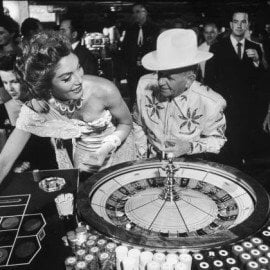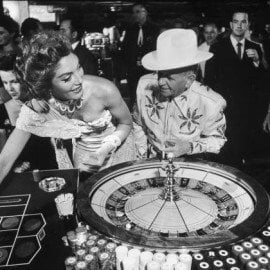
Origins of Roulette
Written by: H. Howard
While the exact origins and development of the roulette game are difficult to evidence, it is relatively easy to compile a rough idea of how the game came about and became as famous as it is today.
It is commonly agreed that the very first roulette wheel was invented by a French physicist Blaise Pascal in 1642 in his attempt to create a perpetual motion machine. However, other legends speak of French monks that created the game as a way to pass the monotonous time of a monastery life.
Regardless of who created the wheel itself, the game of roulette appears to have ancestors in a number of other games. As far back as the Romans, people have bet on the motion of a wheel. A number of other roulette aspects can be seen in earlier games of different kinds.
Origins of Roulette – Even-Odd
Even-Odd was a game played with a wheel and ball similar to that of roulette but, instead of numbers, simply had 20 pockets marked with E for Even and 20 marked O for Odd, plus two house pockets. Although many sources suggest that this was the starting point of roulette, it is difficult to prove as documentation of both games appear at roughly the same point in history.
Origins of Roulette – Hoka
In this game a ball is rolled over a table of 40 holes, each marked with a number. If a ball landed in the hole that a player had bet on, the player won. Within this game there were between three and six cups which were house pockets.
Origins of Roulette – Biribisso
 Biribisso was a popular kind of bingo game between 1600 and 1700 in Italy, with a cloth marked with symbols and numbers for players to place their bets on. The game revolved around balls containing each number which, when picked, would determine the winner of the bets placed on the cloth. The ‘street’ version of this game consisted of 36 numbers, just like that of roulette.
Biribisso was a popular kind of bingo game between 1600 and 1700 in Italy, with a cloth marked with symbols and numbers for players to place their bets on. The game revolved around balls containing each number which, when picked, would determine the winner of the bets placed on the cloth. The ‘street’ version of this game consisted of 36 numbers, just like that of roulette.
While it is difficult to determine exactly when these games came about and if they had any direct influence on the introduction of roulette, it is easy to see how a combination of the popular games at the time could have sparked the creation of roulette with it’s numbered pockets (Hoka), spinning wheel (Even-Odd) and it’s betting cloth (Biribisso).
Early Evidence of Roulette
The earliest recordings of the game itself are legal documents prohibiting the play of roulette and other betting games. In 1758 in New France (Canada) the games of ‘dice, hoca, faro and roulette’ are banned and, even earlier in 1745 in England, documents state that ‘no place shall be kept for playing of the said game of Roulet or Roly-Poly’.
A more favourable early recording of roulette is made in Jacques Lablee’s 1802 book ‘Roulette, or the history of a player’ which describes the game through the eyes of a player in Paris in 1796.
Advancement of Roulette
 Early versions of roulette included two house slots (zero and double zero) which were marked red and black, as with the other numbers on the roulette wheel. As the game increased in popularity through the 1800s, the house slots were changed to green to avoid confusion. In 1843 Francois and Louis Blanc introduced a roulette wheel with just a single house slot. This reduced the house edge, thus making it more appealing to the player and allowing them to compete with other popular casinos. This, of course, is now common in European and French roulette.
Early versions of roulette included two house slots (zero and double zero) which were marked red and black, as with the other numbers on the roulette wheel. As the game increased in popularity through the 1800s, the house slots were changed to green to avoid confusion. In 1843 Francois and Louis Blanc introduced a roulette wheel with just a single house slot. This reduced the house edge, thus making it more appealing to the player and allowing them to compete with other popular casinos. This, of course, is now common in European and French roulette.
The older double zero layout, however, had already made its way to America, hence starting the current game of American roulette with two house slots. American casinos opted to keep the additional house advantage, even adding a third house slot with the symbol of the American Eagle to increase their edge further. Understandably though, this layout never really took off and today wheels with this additional slot are extremely rare.
Despite its popularity, gambling was banned and casinos closed in both France and Germany in the 1800s. This allowed casinos in Monte Carlo to become increasingly popular as it was one of few remaining legal places to gamble. In 1891 there were huge developments in the Monte Carlo scene, with profits being used by Prince Charles, ruler of Monaco, to alleviate financial difficulties in the area.
In 1941, Las Vegas opened its first casino ‘El Rancho Las Vegas’ following the accommodation of thousands of workers for the Hoover Dam, others quickly followed and Vegas soon became the gambling paradise that it is today.
In the early 20th Century it was only these two cities which really provided betting games at casinos. Later on, in the 1970’s casinos started to spring up all across the world, with many realising the fortune that could be made. Betting bans were lifted and roulette flourished as the ‘King of casino games’ due to the single zero and reasonable house odds.
Modern Roulette
Today, roulette is offered at thousands of land based casinos across the world, being the most popular casino game there is (third most popular in America, probably due to the additional house edge)!
In 1997 roulette first appeared online and resulted in an additional boom in popularity. With the ability to play in the comfort of your own home and at your own pace, online roulette appealed to both experienced land based players and those new to the game. The online game initially relied on the technology of random number generators ensuring the fairness of the game. Since then it has become possible to play live roulette from your home, with a real table, wheel and dealer giving a more realistic feel. In the 21st Century, roulette is one of the most popular online casino games and is played by millions across the world!